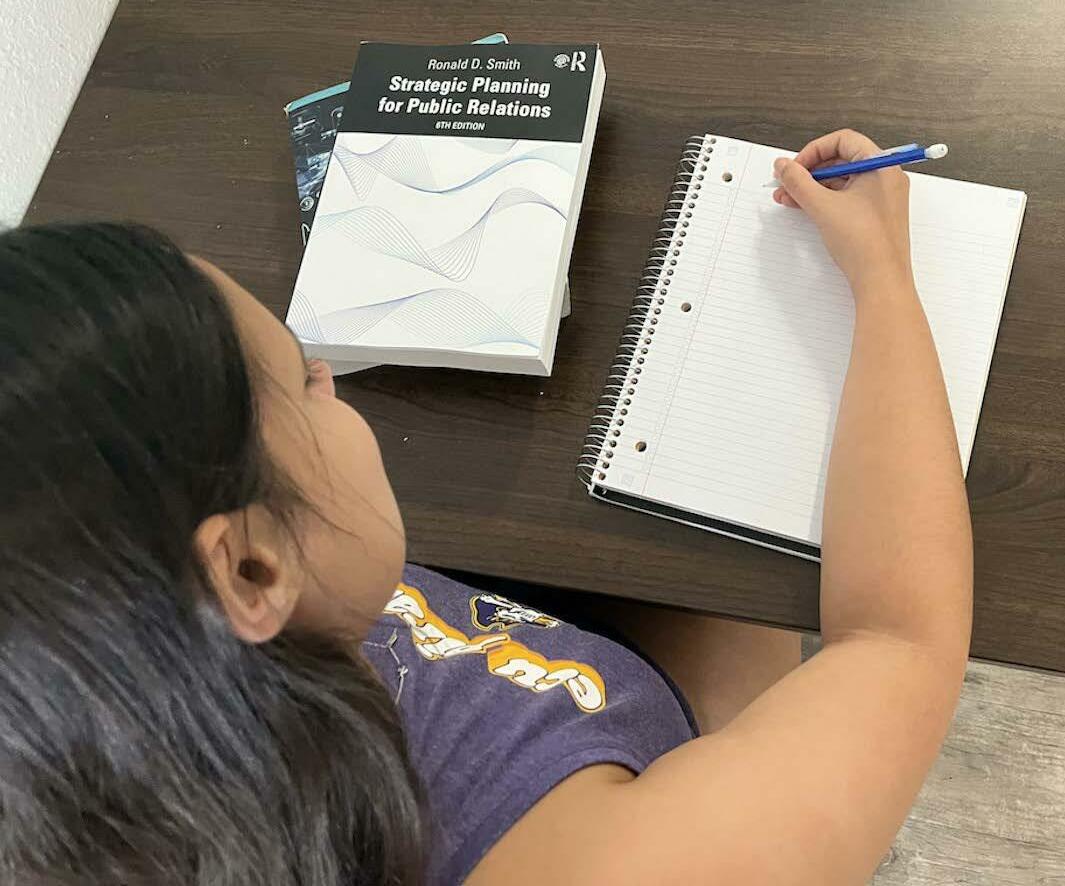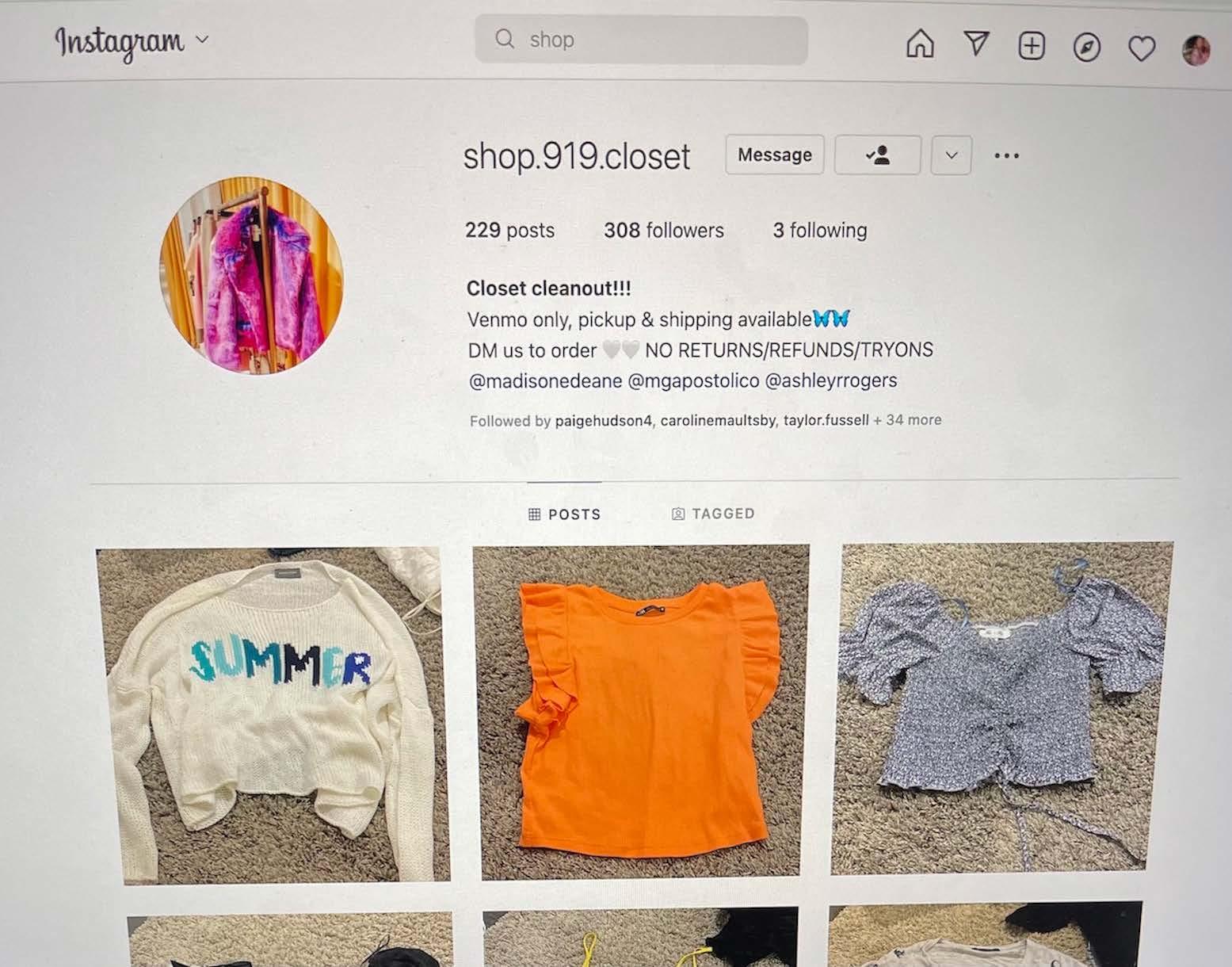Students How 2
A newsletter for you: The college student who wants to learn how to do everything better, easier and cheaper.
Featured:
•How to create a PR campaign
•How to successfully sell your clothes on Instagram
•How to NOT become the intolerable roommate
Help yourself:
College is often referred to as ‘the best time of your life’ but it can also be very stressful. Students need to learn how to balance school, work and their social lives while still struggling with everyday stressors. This newsletter will help you learn various tips and tricks for making student life easier.
Work smarter, not harder and make the most of your college years.

Fall 2022 studentshow2.wordpress.com
1
How 2 create a PR campaign
By Nicole McKillop
know your public, the group of people with similar interests or values you are trying to reach with your campaign. It’s important to understand what they value in a product/ service and what kinds of campaigns would pique their interest.
“Every component is important,” said Dr. Cui Meadows, who teaches ECU’s PR Campaigns capstone course, “but I would say research is most important. You do research in every step of the campaign.”

Know your publics
It’s also important to consider all the different groups that are going to support you (known as enablers), and the groups that are going to go against you (the limiters). Be prepared for any possible outcome, and to create the most appealing campaign directly aimed at your target audience.
As communication students move further along in their studies and define their focus within their major, their tasks become less about learning new material, and more about taking the concepts they’ve learned and applying their studies to real-life projects. In a public relations (PR) concentration, as students near the end of their studies begin to apply the theories and concepts they’ve learned and implement them into a PR campaign. In this article, PR students can learn what goes into an effective PR campaign.
Campaign modeling: research
A common model students follow in PR when creating a campaign is the RACE model, which stands for Research, Action-planning, Communication and Evaluation. The first two steps, Research and Action-planning, are crucial to creating an effective campaign.
There is a lot of background work that goes into a PR campaign that the public is unaware of. Within the Research portion, a key thing to remember is to
“A professional has to have a good understanding of their public,” said Meadows, “What are their wants and needs? Don’t create a campaign for all. Really segment and research your public and tailor your message.”
Professionals can target their audience’s wants and needs to tailor their messages by creating an open and interactive space with their consumers. Many companies nowadays lean towards social media channels as ways to connect with and understand their audience. They can track who they follow, what content they like, and cater their messages towards what the people want to see and hear from them.
Taking action
After you have defined your public, what they are interested in, and trends they may follow, and have explored all possible outcomes with your customers as well as your limiters to remain prepared, you can move into the next step: Action-planning. You need to decide what message you want to say and get across to your audience.
PR student outside of ECU's Joyner East School of Communication.
Continued on page 3 2
Photo by Nicole McKillop
“Nowadays consumers are looking for relatable aspects to a brand. People want to feel seen,” said Meaghan Skelly, a junior communication student at ECU who will soon be enrolling in the PR campaigns course. “I think building an emotional connection within clientele has been working really well in the PR world recently.”
Brands and organizations can build these emotional connections with clientele through researching their demographic and finding what other topics, social issues and organizations they are interested in that appeal most to them. For example, in today’s market, more clothing and fashion brands that are targeted towards a female audience are using messages that emphasize body positivity and making women of all shapes and sizes feel beautiful, appreciated and represented.
In Action-planning, two key terms to keep in mind are strategies and tactics. In this stage, you begin to implement your goals and create ideas for how you want to get your message across.

Strategies are your overarching ideas of what you want to accomplish and tactics are how you want to get that done. For example, a strategy can be that you want to educate your audience on a certain social topic/issue, and the tactics would be things like recording informative videos or creating eye-catching infographics to use as posters. These two concepts work hand in hand to help you organize and plan

your PR campaign and visualize how to accomplish your goals.


Implementation & evaluation
The final two steps are Communication and Evaluation. These steps include implementing your Action-planning strategies and tactics, and then later evaluating what worked well and what could be improved in your campaign.
Ways to track evaluation involves methods like measuring impressions of the tactics utilized in the implementation stage, checking statistics from online and social media platforms, gauging public opinion online and in person, and seeing the effect your tactics have on your business, brand or organization’s sales or overall traffic and awareness.

It is commonly believed amongst PR professionals that background work, analyzing your public, and strategy planning are the most important steps in creating a PR campaign.
If you keep these steps with the RACE model in mind and put the time and effort into knowing your public and your mission, the campaign you deliver will likel be a hit and will keep the people wanting more.
For more resources and examples of successful PR campaigns, go to https://www.meltwater.com/en/ blog/best-pr-campaigns.
3
PR student starting to record her thoughts and objectives.
The RACE Model Public Relations Research: Action: Communication: Evaluation: What is the problem or situation? What is going to be done about it? How will the public be told? Was the audience reached? what was the effect?
Photo by Nicole McKillop
How 2 successfully sell your clothes on Instagram
 By Madison Deane
By Madison Deane
During my sophomore year of high school, I decided that a closet cleanout was a must. Dresses and tops were pilling on top of one another and the thought of keeping every article of clothing overwhelmed me.
Inspiration struck my mind after seeing influencers blogging about selling clothes and items online, whether this was through Poshmark, Mercari or Depop. I soon turned to social media, a place where I felt I could express myself and display content that I loved to friends, family and peers. However, I had trouble getting started. I felt defeated after spending countless hours online researching how influencers had built such success.
As a junior in college, I have finally learned tips, tricks and tools that are used to keep consumers wanting more. These skills can help others flourish in their marketing on the social media platform.
Creating a platform
When it comes down to establishing your social media platform, starting from the bottom does not
always come easy. Building a strong foundation for consumers and followers takes time but is worth it in the end.
Betsy Burleson, founder of “Two Peas in a Blog,” a site on which twin sisters discuss the latest fashion trends, explains how she patiently built her social media platform.
“We’d write blog posts about our looks, what we were loving and what was trending, and added the links to shop within the posts. At this point we weren’t making any commission or money off it,” Burleson says. “Once Instagram and social media took off, we shifted to more content there and less on our blog. In the beginning, we posted to the blog usually six days a week. Now it’s more like one to two a week, sometimes less. Social media is where all the interest and followers are now.”
To grow over any social media platform, trust and patience come hand in hand. Starting with only a few customers and followers is just the beginning of a long-term business.
Madison’s closet account on instagram.
Continued on page 5 4
Photo by Madison Deane
Post pricing, size and if it has been worn. List clear images of your items that allow customers to see it on as well.
by Madison Deane
Want to read more student How-2s?
Visit: studentshow2. wordpress.com
“This isn’t a get-rich-quick job. You have to create a trusted following, which takes time. Even if it’s fifty followers, you need to focus on those fifty people. Don’t always be looking to gain more,” Burleson advises.
Pricing
To create profit, pricing needs to be consistent. This means that the items listed should be based on how many times the items have been worn, the quality of the product and the original retail cost.
Emory Knott, owner of buy.ourstyle on Instagram, explains how she handles pricing items and shipping costs.
“Pricing an item primarily depends on the wear of the piece. If the product is in great condition with minimum wear, the percentage marked down will be less. Vise versa for a worn-down item,” Knott explains. “Shipping costs depend on the weight of the package. We charge $6-10 on our garments. Shoes typically are more due to the weight of the shoe.”
Quality media posts
Creating content for your followers and consumers is a great way to keep them engaged and steady with your account. Creators need to use the best media, whether this is through video or pictures, to help promote/sell clothes.
Burleson gives her take on the best way to engage her consumers. “For us, we see the most success with a combo of still pics and try-on. People want to see how it looks on and get the sizing/fit info from a try-on. We either post a still picture or reel on our
Instagram feed then back it up with try-on videos on our Instagram stories,” Burleson says. “Instagram stories are huge for making sales. People want to see the product on, as you’re wearing it and in real life.” Giving the followers what they want will always attract more.


Burleson concludes, “Poll them, ask them what they are loving from you, what they want to see more of. Everyone has a different personality and style to share. Make sure your true self shows through. That is what followers can relate to.”
With these tips and plans of action in mind, creating your digital platform will no longer be a struggle but a hustle. Focus on each point made from the following and success will likely come your way.
Upload quality media with good lighting and neutral backgrounds.
Photo
Photo by Madison Deane
5
How 2 be a considerate roommate
By Ella Doran
One of the most exciting parts of going off to college is getting to live with a roommate. Many people have good experiences and become best friends. Others aren’t so lucky, however. These are a few tips and tricks to ensure you don’t become an intolerable roommate.

Neatness
The first aspect of being a good roommate is tidiness. College dorms can be small and can feel even smaller when sharing that space. Keeping the room uncluttered can make it feel bigger. Tidiness can also help with mental health. According to research conducted by the University of South Carolina’s Paul Bliese, having a comfortable environment is essential for mental hygiene.
Another important aspect of dorm living is cleanliness. Remember, it’s not just you living in this small space and any scent in the room can be sniffed out by both roommates.
Jordan Stallworth is a senior at ECU and lived in the dorms for two years. When asked what his
biggest annoyance was when living with a roommate, his answer was “never having a clean room.”
Hygiene
The showers should be used every day, especially on those hot and humid days walking to class. Laundry should be done weekly as it can start to funk up a room in no time. A hack to keeping your dirty laundry from releasing too much of a smell is to get a laundry basket that has a drawstring at the top. This will trap odors in instead of letting them escape into the room.
Another trick is to keep your detergent and dryer sheets in your hamper or dirty clothes basket. The box of dryer sheets will help mask any smells. This can also free up storage space and help you remmeber to bring these items to the laundry room when it’s time to do laundry.
Roommates studying in a cohesive dorm room.
Continued on page 7 6
Photo courtesy of publicdomainpicturs.net
Consideration
Consideration for your roommate will score you big points and help you out in the long run. Many people have different class schedules. If you have an 8 a.m. class and your roommate is trying to sleep in, get ready quietly. If you need to stay up late to cram for an exam, make use of the library or study rooms. If you take the last paper towel or tissue, replace it at your earliest convenience.
Carey Stancil, a residence hall coordinator at East Carolina University, said, “The most frequent complaints that I see have to do with physical space and items.” He used someone having their friends over and letting them sit on their roommate’s bed or letting them touch items that didn’t belong to them as examples. Stancil suggested, “setting a specific place for guests to hang out,” such as a sitting area.
Sharing
Don’t assume ‘what’s mine is yours.’ A good way to keep your food or belongings to yourself is to have separate sides of shared storage. Whether it is a minifridge, food cabinet or closet, have your own shelf or side to ensure there is no confusion about whose stuff is whose. If you and your roommate are okay with sharing certain items, make sure you establish exactly which items those are.

Communication
Communication will be needed in all aspects of life, but it will definitely help when you must share a space. If your roommate is doing something that you do not appreciate, they will never know if you don’t address it and vice versa. Along with communication is being able to receive feedback or criticism.
Stancil suggests, “setting expectations with your roommate early and firmly, but nicely and not waiting until there’s a conflict to have that conversation.” He said, “Be a good roommate by listening to what your roommate is comfortable with and not comfortable with.”
Living in the same room as another person won’t always be a piece of cake. There are many ways to avoid roommate troubles, but some are inevitable. When these situations arise, have a conversation. If this doesn’t work, talk to your RA or dorm advisor. They can set up a mediation or help with additional steps if necessary.
 Keep dryer sheets inside dirty clothes basket and keep drawstrings closed to mask any smell.
Photo by Ella Doran
Have separate shelves for personal food items not for sharing.
Keep dryer sheets inside dirty clothes basket and keep drawstrings closed to mask any smell.
Photo by Ella Doran
Have separate shelves for personal food items not for sharing.
7
Photo by Ella Doran
Both the content for this newsletter and the design are created by students enrolled in COMM 3310: Copy Editing and Design in the School of Communication at East Carolina University in Greenville, North Carolina during the Spring and Fall semesters under the direction of course instructor Barbara Bullington.
We welcome suggestions for article ideas for future issues. For inquiries, please email bullingtonb@ecu.edu
 Photo by Brendan Cavazos
Photo by Brendan Cavazos








 By Madison Deane
By Madison Deane




 Keep dryer sheets inside dirty clothes basket and keep drawstrings closed to mask any smell.
Photo by Ella Doran
Have separate shelves for personal food items not for sharing.
Keep dryer sheets inside dirty clothes basket and keep drawstrings closed to mask any smell.
Photo by Ella Doran
Have separate shelves for personal food items not for sharing.
 Photo by Brendan Cavazos
Photo by Brendan Cavazos